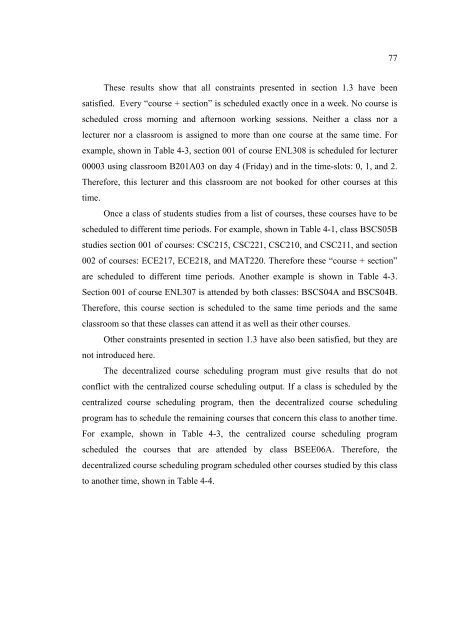a multi-objective bisexual reproduction genetic algorithm for ...
a multi-objective bisexual reproduction genetic algorithm for ...
a multi-objective bisexual reproduction genetic algorithm for ...
Create successful ePaper yourself
Turn your PDF publications into a flip-book with our unique Google optimized e-Paper software.
77<br />
These results show that all constraints presented in section 1.3 have been<br />
satisfied. Every “course + section” is scheduled exactly once in a week. No course is<br />
scheduled cross morning and afternoon working sessions. Neither a class nor a<br />
lecturer nor a classroom is assigned to more than one course at the same time. For<br />
example, shown in Table 4-3, section 001 of course ENL308 is scheduled <strong>for</strong> lecturer<br />
00003 using classroom B201A03 on day 4 (Friday) and in the time-slots: 0, 1, and 2.<br />
There<strong>for</strong>e, this lecturer and this classroom are not booked <strong>for</strong> other courses at this<br />
time.<br />
Once a class of students studies from a list of courses, these courses have to be<br />
scheduled to different time periods. For example, shown in Table 4-1, class BSCS05B<br />
studies section 001 of courses: CSC215, CSC221, CSC210, and CSC211, and section<br />
002 of courses: ECE217, ECE218, and MAT220. There<strong>for</strong>e these “course + section”<br />
are scheduled to different time periods. Another example is shown in Table 4-3.<br />
Section 001 of course ENL307 is attended by both classes: BSCS04A and BSCS04B.<br />
There<strong>for</strong>e, this course section is scheduled to the same time periods and the same<br />
classroom so that these classes can attend it as well as their other courses.<br />
Other constraints presented in section 1.3 have also been satisfied, but they are<br />
not introduced here.<br />
The decentralized course scheduling program must give results that do not<br />
conflict with the centralized course scheduling output. If a class is scheduled by the<br />
centralized course scheduling program, then the decentralized course scheduling<br />
program has to schedule the remaining courses that concern this class to another time.<br />
For example, shown in Table 4-3, the centralized course scheduling program<br />
scheduled the courses that are attended by class BSEE06A. There<strong>for</strong>e, the<br />
decentralized course scheduling program scheduled other courses studied by this class<br />
to another time, shown in Table 4-4.













